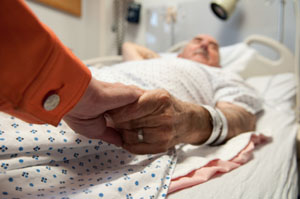Nearly four out of five hospices have enrollment policies that keep away patients with potentially high-cost medical needs, such as palliative chemotherapy and intravenous feeding tubes, according to a new study.
Hospice is one of the fastest growing segments of Medicare, and many health policy experts laud it as a humane and cheaper way to care for people in the last half-year of life. But in surveying hospices, the new study warns Medicare’s method of paying a fixed daily fee to hospices may be discouraging many from taking on patients with expensive needs.
The study published Monday in the journal Health Affairs found that for-profit hospices, which have bloomed around the country over the last decade, are more likely than are nonprofits to limit which patients they will accept based on their special needs. The smallest hospices, which care for 20 or fewer patients a day on average, also were more likely to turn away patients with expensive needs, according the study. The authors noted that larger hospice volume “enables hospices to spread the financial risk of high cost-patients.”
The study was based on a survey conducted in 2008 and 2009, ultimately compiling responses from 591 hospices. The study found 61 percent of hospices would not accept patients who wanted chemotherapy, which can be used to help ease their pain in their dying days. Fifty-five percent would not accept patients who could only be fed intravenously, and 40 percent would not accept patients who were receiving blood transfusions.
Nearly a third of hospices would not take patients who were getting palliative radiation or taking pain medication through a catheter operated by an automatic pump. One out of eight hospices required a patient to have a caregiver at home in order to get the hospices’ services, which include visits from nurses and social workers. Overall, 78 percent of the surveyed hospices had at least one of the seven restrictive enrollment rules they were queried about.
Melissa Aldridge Carlson, the study’s lead author, said the results reflect general awareness among the hospice community that Medicare’s reimbursement rates aren’t high enough to pay for these more expensive medical services. Medicare reimburses $153 a day for routine hospice care and $896 a day for around-the-clock care, according to the Centers for Medicare & Medicaid Services. The paper’s authors say that may be too low and recommends Medicare increase its reimbursement rates so that “such patients would not be as financially risky for hospices to enroll, and enrollment might become less restrictive.”
Some of the services that the researchers looked at, like radiation and chemotherapy, fall into a murky area for hospice. In order to qualify for the Medicare’s hospice benefit, beneficiaries must agree to forgo any curative treatments. But some patients find that radiation and chemotherapy can help control their pain. That kind of care, the study noted, can cost more than $10,000 a month.







